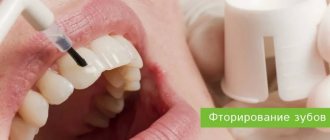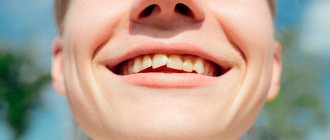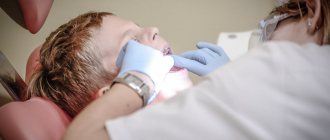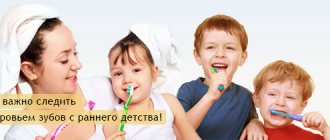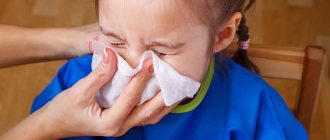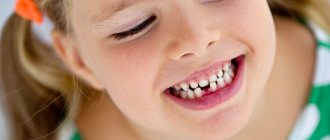Teething in children
In what order do children cut teeth? As a rule, this is the following order of growth of baby teeth:
- First two lower central incisors – 6-8 months
- First two upper central incisors – about 8 months
- First two upper lateral incisors – 8-12 months
- First two lower lateral incisors – 10-12 months
- First four chewing teeth – 14-20 months
- First four canines – 18-24 months
- Second four chewing teeth – 2-3 years
When do babies start teething?
The birth of a first child involves a lot of unknowns for young parents; so many new things await them ahead. Of course, parents are concerned that the baby grows and develops correctly. Gradually, the baby goes through important stages: he begins to smile, roll over from back to side, and sleep without waking all night. Another significant event that parents look forward to is the appearance of the first tooth. Parents are concerned with the question: “When do children start teething?”
Signs of teething
You will notice this in the child's behavior and condition. When teething, the baby puts everything in his mouth to scratch his gums. His salivation increases, his appetite worsens, and his gums swell. The baby is capricious and sleeps restlessly.
If your child has a high fever and/or diarrhea, you should make an appointment with your pediatrician. These symptoms cannot be attributed to mild teething discomfort. Remember that the child’s immunity is just beginning to develop at this age. Babies put all toys and objects into their mouths, whether clean or dirty, so they risk becoming infected with bacteria and viruses.
How to help your child relieve pain
Pediatric dentists have developed a number of tips and recommendations to help relieve infants' pain and discomfort. Modern medicine does not recommend applying topical numbing gels and liquids to the gums due to the risk of toxicity in children 2 years of age and younger. Another outdated remedy recognized as harmful to teeth is dipping a pacifier in sugar or honey.
Don't worry, there are many simple and harmless ways to make your baby's life easier. Try giving him a clean, durable teething ring or a cool pacifier. Store spare teethers in the freezer so you always have them on hand. Cold foods help fight unpleasant symptoms if the child can already eat them, for example, ice cream and frozen fruit. Gently massaging your gums will help relieve pain. If the pain is severe, contact your pediatrician, who will recommend an over-the-counter medicine for babies. Be careful and notice which method best helps your child.
Teething schedule _
Noticing increased salivation, parents immediately begin to look for the first tooth in the child’s mouth. The two lower central incisors appear first when the baby is about 6 months old. However, no two children are alike; The first tooth may appear at 5 months or at 12 months. So, the correct answer to the question “when do babies start teething” is: “any time they want.”
After the first teeth appear, on schedule or off schedule, you wonder when to expect the next ones. The two upper central teeth emerge between approximately 9 and 13 months of age. Between 13 and 16 months of age, many children have four front teeth on the bottom and four on top. The remaining primary teeth, the lateral incisors and molars, should emerge by age 2 to 3 years. It's a long process, but when it's all over, your baby will have 20 baby teeth!
The important role of baby teeth
Some parents believe that baby teeth are not very important because they will eventually be replaced by permanent teeth. However, this is precisely why it is necessary to take care of baby teeth! They not only make the baby’s smile beautiful, but also help him learn to speak and chew food. These 20 teeth provide the necessary space for the development, growth and proper positioning of permanent teeth.
It is impossible to overestimate the importance of proper care of a child's teeth and gums from the very beginning of teething. Specialists of the Russian Medical Server consider oral hygiene and regular visits to the dentist to be the best methods for preventing dental diseases. A child's last baby tooth will fall out in early adolescence, around 12 years of age. Be patient and surround your child with care so that this difficult period passes safely.
Teething symptoms
What are the symptoms of teething in a one-year-old child? What are the symptoms of teething in children? Typically, symptoms of teething in children under one year old include:
- Profuse salivation. It may cause coughing and hoarseness, as well as a rash in the mouth and chin.
- Swelling, redness and soreness of the gums
- Itchy gums. Babies often try to relieve it by chewing almost anything they can get their hands on.
- Decreased appetite or complete absence of it, as well as refusal to eat
- Temperature increase
- Sleep disturbance
- Increased excitability
- Changing the stool
- Runny nose
It is important to understand that when teething in children, the symptoms can be different and it is not at all necessary that the child has everything on the list. Symptoms of teething in children after one year are very often similar to those present before one year. Even when molars erupt in children, the symptoms may be similar, but everything, of course, is purely individual.
How to feed a child during this period?
Despite general malaise and refusal to eat, the child should not be allowed to go without eating for a long time. Pediatricians recommend adhering to the following rules:
- Maintain drinking regime. During the dental period, the baby should receive a sufficient amount of fluid. This can avoid dehydration, reduce the temperature, and also improve the general condition of the child.
- If the baby is breastfed, give him breastfeeding on demand. Refusal to breastfeed is a reason to feed him with a spoon or glass. At this time, you should not introduce new products, give only those to which the child is already accustomed.
- If your baby is prone to diarrhea, you can reduce the amount of vegetables and fruits in his diet. Let him eat porridge, crackers, and children's cookies instead. If your baby has already tried compote, you can offer him jelly, which will help improve the functioning of his stomach.
Complications during teething
It is important to monitor the symptoms of a child’s first teeth erupting in order to predict complications. Complications may include:
- Early teething. The norm is 6 months, but it may be that the child’s teeth begin to erupt at 2 months
- Too late teething. It is possible that even at 8 months the child has not yet erupted teeth. The consequence of this situation can be edentia - this is the complete or partial absence of teeth in the oral cavity.
- Incorrect teething sequence
- Abnormal tooth formation or dental anomalies
- Tooth growth abnormalities
- Enamel hypoplasia. It is a lesion of tooth enamel that occurs in children under 10 months of age.
- Aphthous ulcers or aphthous stomatitis. It is the process of small purulent ulcers appearing in the mouth
- Gum hematoma. May occur when a blood vessel is damaged
At the INTAN implantation and dentistry centers you can provide a wide range of pediatric dentistry services. All services are provided only by highly qualified dentists who have a special approach to children and knowledge of how to carry out treatment so that the little patient likes it.
Pain relief at home
At home, you can alleviate the child’s condition. The problem should be approached comprehensively. In addition to changing your diet, you should also think about medications. It is with the help of medications that you can help your baby cope with discomfort and pain. Let's consider what remedies can be taken internally, externally and how to act using traditional methods.
READ ALSO: How long does it take for a child to cut his first teeth?
Medicines for oral administration
First, let's figure out what medications can alleviate the child's general condition. It is impossible to speed up or change the process of teething, but parents are quite capable of stopping the symptoms. If the baby feels pain, cries, chews his fists and sleeps poorly, you can give him paracetamol-based drugs. The medicine will relieve pain and slightly reduce the temperature. Ibuprofen products act similarly, but their effect is stronger.
READ ALSO: What should you smear on your baby’s gums when teething?
It is acceptable to use homeopathic medicines. Today, Dentokind tablets are quite popular and can be given to infants. According to the manufacturer, the product removes the symptoms inherent in teething - fever, pain, itching. The tablet dissolves easily in a teaspoon of boiled water.
Use of gels and ointments
If the baby is very restless, topical medications can be used. The pharmacy sells gels and ointments that need to be applied directly to the gums. Swollen areas should be smeared after meals and can be done several times a day. The gels contain painkillers and anti-inflammatory components. Some of them are cooling. The most relevant products for infants:
- Dentinox gel (includes fructose, allergies are possible),
- Dentol-baby product,
- Cholisal gel,
- Kalgel drug (from 5 months).
At the pharmacy, the pharmacist may recommend purchasing another product that is available. It is important that the drug is suitable for the child’s age and does not cause allergies.
Homeopathy also offers its own remedies for topical use. Oh and Baby Doctor.
The need to see a doctor
A visit to the pediatrician is planned if:
- a high temperature lasts for 2-3 days - this could be an acute respiratory viral infection, an intestinal infection;
- the new tooth is much darker or has an irregular shape;
- incorrect position of the tooth, it protrudes from the arch or is too far from the standard location in the row;
- the order of teeth eruption is disturbed.
It is necessary to be examined by a doctor if the baby is already one year old and has no teeth yet.
Teething – how to help your baby?
I.A.
KHOSHCHEVSKAYA , Candidate of Medical Sciences,
Head of the Department of Pediatric Dentistry, St. Petersburg Institute of Postgraduate Dentistry
The article discusses the problems that children and their parents face in the process of teething in infants and the possibilities of alleviating the child’s condition.
The fundamental difference between a child’s body and an adult’s is the growth, formation, and development of all organs and systems. Teething is one of the most important signs of a child’s physical development. Therefore, parents are happy when their baby gets his first tooth in due time, and grandparents have already bought a silver spoon for this event. But from this moment on, an allegedly visible reason for any child’s ailment appears.
Normally, in a newborn, the crowns of the front baby teeth are already formed, but lie in the dental sacs of the jaw. After birth, the formation and growth of roots, as well as the formation of interalveolar septa, begin. Then atrophy of the gum area occurs, and the crown comes to the surface.
“Teething” is a phrase familiar to many adults (both doctors and parents), who explain many infant problems with this very circumstance: from the child’s seemingly unmotivated restlessness and problems falling asleep to increased body temperature, runny nose and bowel movements. The conclusion naturally suggests itself when it is impossible to find a visible cause for any ailment, the teeth are necessarily “to blame” for this.
Therefore, on behalf of pediatric dentists, let me try to streamline the cause-and-effect relationships when it comes to dental problems. We immediately emphasize that there are always exceptions to the majority, which are associated with individual characteristics.
So, point by point
The child’s restlessness and increased activity are associated primarily with the psychophysiological characteristics of the baby, whose inhibition processes do not keep up with the excitation processes. Every day and every minute a child receives so much information that even an adult who has seen a lot in life would not be able to cope with it, but for a child it’s EVERYTHING FOR THE FIRST TIME!!!
That’s why a calm environment in the house, a routine, walks, age-appropriate toys, and a falling asleep ritual are so important.
“The gums itch and itch, so the child puts everything in his mouth.”
We can all only assume that teething is accompanied by itching, since not a single child has yet told anyone about this. But everyone knows that permanent teeth erupt after temporary teeth fall out so calmly that it goes almost unnoticed (there is an exception - the difficult eruption of “wisdom teeth”, for which there is often simply no room).
“...He puts everything into his mouth” a child, in principle, puts everything into his mouth, the grasping reflex and the knowledge of everything new by taste and touch - every person has gone through this, and the reason for this is not so much the teeth, but the stages of personality formation.
Stool disorder - a child is born with a sterile oral cavity and gastrointestinal tract. Sleepless nights due to colic, when the microbiocenosis of the gastrointestinal tract is developing, often begins long before teething begins. However, disruption of digestive processes can also be an indirect symptom of teething. According to a study by Peretz B., up to 35% of children suffer from bowel disorders during this period.
Increased body temperature
Teething is one of the stages of tooth development, i.e., the process is physiological, not pathological, so it is logical that teething itself is not the cause of an increase in body temperature. During teething, the temperature, being a fairly common symptom, does not exceed subfebrile numbers of 37.5–38 C. This is due to the release of biologically active substances in the tooth growth zone. With severe hyperthermia, it is necessary to look for another cause.
But there are the following objective factors that do not require evidence and can contribute to the appearance of the above symptoms: structural features of the gums in infants (more delicate connective tissue, high permeability of the mucous membrane, thin epithelial layer, fewer elastic fibers and more cellular elements, abundant blood supply). Thus, histological and histochemical features of the structure of the oral mucosa (OM) of children under 3 years of age indicate the presence of morphological reactions of maturation of the immune system against the background of its increased permeability, which causes high susceptibility of the mucosa to infectious and viral agents.
passive immunity acquired during the antenatal period (interplacental) fades by the age of 1 year, and the immune properties of tissues (antibodies, hormones, enzymes) are lost. Against this background, the child’s resistance to viral, bacterial and fungal infections of the oral mucosa decreases. Your own active immunity is only in its infancy. This circumstance explains the easy infection of microtraumas, which cannot be avoided, because the child puts everything in his mouth...
Considering these objective circumstances, we come to the main thing: how and how we can help our little patients, who during the period of teething have an additional reason for restless behavior:
1. If the child is already good at grasping and holding toys, give him a special teether - safe, comfortable, bright, and if it’s also chilled - absolutely good. 2. To reduce swelling, sedatives, painkillers, and anti-inflammatory drugs are recommended. Preparations containing an anesthetic (for example, lidocaine) have long been known. There is a BUT: since metabolic processes in children are much more active, it is advisable, if possible, to avoid the use of drugs that can contribute to allergization.
Preferable drugs based on natural ingredients - for example Dantinorm Baby.
Contains only herbal ingredients:
— chamomile (Chamomilla vulgaris); - Indian ivy (Phytolacca decandra); - rhubarb (Rheum of finale).
The drug is easy to use: one sterile container for one instillation into the mouth, while direct contact of the drug with the hands is excluded - this is convenient both at home and while walking and traveling. Modern parents are very active and mobile, so the arrival of a baby in the family is not an obstacle even to long journeys. Important! During the use of the drug since 1994, no side effects have been identified in world practice.
For doctors and parents, experience in using a particular drug is important; word of mouth is one of the most powerful arguments when choosing a medicine for a child.
The following facts speak for themselves:
— 7 out of 10 French pediatricians recommend Dantinorm Baby (based on the results of the TOLUNA study, 2010); - 9 out of 10 mothers who have already given the drug to their children will purchase it again (results of the TOLUNA consumer behavior study, France, 2012).
Dental signs of normal physical development - teething - timely, - paired and - sequential.
When examining a child, the dentist evaluates many parameters. The doctor evaluates how the child behaves in the dentist’s office, whether his development corresponds to his age, compares the child’s height and weight, and so on. When assessing the oral cavity, the dentist evaluates not only the health of the oral cavity and the timing of teething, their number, but also the so-called. principle of pairing. Normally, teething occurs according to a certain principle. Most often, the front incisors on the lower jaw erupt first, and after some time the teeth of the same name on the upper jaw erupt. This is what is called the principle of pairing. The second important parameter is the number of teeth in the oral cavity, which must correspond to average statistical standards.
Possible features of teeth in children at the teething stage
• Expansion of spaces between teeth. It may reflect increased jaw growth and during the transition period from baby teeth to permanent teeth is regarded as a normal condition. A wide gap between the front incisors on the upper jaw is usually associated with a deep-lying maxillary frenulum. The tactics for monitoring and treating wide gaps between teeth are determined by an orthodontist. • A blackish edging on the neck of the tooth can occur due to the use of soluble iron supplements or a chronic inflammatory process (precipitation of leptotrichium bacteria). • Yellowish-brown staining of teeth is most often associated with the use of antibiotics by the mother in the second half of pregnancy or by the child during the period of teeth formation. • Yellowish-greenish coloration develops with severe disorders of bilirubin metabolism and hemolytic conditions. • Reddish staining of tooth enamel is characteristic of a congenital disorder of porphyrin metabolism (porphyria). • Malocclusion occurs due to uneven growth of the jaws, due to prolonged sucking of the nipple. • Anomalies in the location of teeth occur for constitutional reasons (small jaw size), due to trauma, congenital disorders of connective tissue metabolism, and tumors of the alveolar process of the jaw. • Absence of teeth before 1 year of age is extremely rarely associated with edentia - the absence of their rudiments. You can check the presence of tooth germs using a special radiovisiography method prescribed by a pediatric dentist.
In some cases, the baby experiences a delay in teething or, conversely, the baby’s teeth erupt long before the average. All these conditions frighten parents very much, but the timing of teething is calculated arbitrarily, for healthy full-term children, without taking into account a number of features.
First of all, this concerns the course of pregnancy, when in the first trimester the formation of the rudiments of baby teeth occurs. Toxicoses, improper and inadequate nutrition, taking certain medications, stress, gynecological and obstetric pathologies, smoking, drinking alcohol, etc. can be factors that influence the prolongation of teething. Bad habits contribute not only to delayed teething, but also to the development of certain anomalies in the development of the maxillofacial region. The age of the parents, the duration of the pregnancy and, of course, the health status of both parents can have a certain influence on teething. Various diseases, especially infectious ones, suffered by the child himself in the neonatal period (from birth to 28 days) and/or at any childhood age, when dentin and enamel are formed and formed, can lead to disruption of teething. Such diseases may be measles, rubella, congenital syphilis, gastrointestinal diseases, etc. Also, the causes may be exposure to a harmful environment on the fetus during pregnancy or in neonatal and/or early childhood. In addition, the cause of teething disorders may be heredity or individual characteristics of the body. Delayed teething, of course, may indicate the presence of some pathology, for example, a violation of metabolic processes - rickets and rickets-like conditions; for endocrine diseases, such as hypothyroidism.
Therefore, violation of the timing and sequence of teething should alert specialists observing the child (pediatrician and dentist), and if necessary, an in-depth examination of the child is recommended for timely correction of somatic pathology.
Literature:
1. Schour I., Massler M. // J. Am. Dent. Assoc. 2001. No. 28. P. 53–60. 2. Nolla CM // ASDC J. Dent. Child. 2002. No. 27. P. 30–60. 3. Moorrees CFA, Fannig EA, Hunt EEJ // J. Dent. Res. 1995. V. 42. P. 442–550. 4. Proffit WR, Vig KW // J. Clin. Pediatr. Dent. 1997. No. 21. P. 205–211. 5. Peretz B., Ram D., Hermida L. et al. Systemic manifestations during eruption of primary teeth in infants // J. Dent. Child. 2003. No. 70. R. 170–173. 6. Hertl M. Differential diagnosis in pediatrics. M.: Medicine, 1990. T. 1. P. 549. 7. Dyakova S.V. Pediatric dentistry. 5th ed., revised. and additional 8. Danilevsky N.F., Lenontiev V.K., Nesin A.F., Rakhniy Zh.I. Diseases of the oral mucosa. Publishing house OJSC "Dentistry", 2007. 9. Kazyukova T.V., Dudina T.A., Kotlukov V.K., Shevchenko N.N., Rusakova V.D. Teething Symptoms in Babies: Condition or Disease?
When to sound the alarm
In those places where teeth erupt, many biologically active substances are released, for example, histamine, leukotrienes, prostaglandins, etc. They cause the symptoms that every parent is familiar with:
- Temperature increase. Normally, when teething, the temperature should be low-grade, that is, no more than 38 degrees;
- Swelling, pain and redness of the gums.
This is a normal baby reaction to teething. As a rule, the baby refuses to eat, but at the same time pulls toys into his mouth to chew on them. Due to the fact that the child constantly chews something, the nerves of the gums are irritated and a lot of saliva is released, and since the child does not yet know how to control saliva, it flows out of the mouth. The child also becomes more excitable than usual - he sleeps less, is constantly capricious, and becomes irritable.
Life hack: to help your child and relieve tooth pain, buy a special teething toy. This toy can be filled with water and placed in the refrigerator. When the baby chews on it, the toy will cool the inflamed gums and thereby partially relieve the pain.
But there are symptoms that parents often confuse with a normal reaction to the appearance of teeth:
— Digestive disorders – diarrhea, vomiting, loose stools;
— Temperature above 38-39 degrees, which does not subside for several days;
- Cough, rash, swelling.
These symptoms indicate that there is an infection in the child’s body that needs to be treated.
